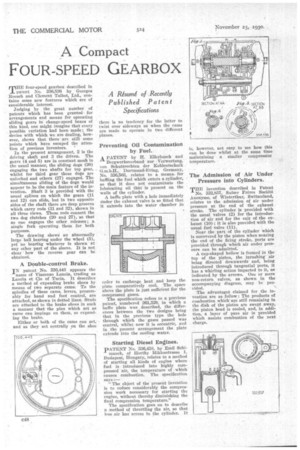A Compact
Page 70

If you've noticed an error in this article please click here to report it so we can fix it.
FOUR-SPEED GEARBOX
A Nsurn1 of :Recently Published Patent • Specifications
TR'
four-speed gearbox described in patent No. 336,536 by Georges lioesch and Clement Talbot, Ltd., contains some new features which are of considerable interest.
Judging by the great number of patents which has been granted for arrangements and means for operating sliding gears in change-speed boxes of this kind, one might imagine that every possible variation had been made; the device with which we are dealing, however, shows that there are still some points which have escaped the attention of previous inventors.
In the present arrangement, 2 is the driving shaft and 3 the driven. The gears (4 and 5) are in constant mesh in the usual manner, the sliding dogs (20) engaging the two shafts for top gear, whilst for third gear these dogs are unlocked and others (27) engaged. The simultaneous sliding of the dogs would appear to be the main feature of the invention. Shaft 3 is provided with the usual splines on which the gears (11 and 12) can slide, but in two opposite sides of the shaft there are deep grooves which carry rods (31 and 32), shown in all three views. These rods connect the two dog clutches (20 and 27), so that as one engages the other releases ; single fork operating, them for both purposes.
The drawing show an abnormally large' ball bearing under the wheel (5), yet no bearing whatever is shown at any other part of the sleeve. It is not clear • how the reverse gear can be obtained.
A Double-control Brake.
IN patent No. 336,443 appears the name of Vincenzo Lancia, trading as Lancia et Cie of Turin. It describes a method of expanding brake shoes by means of two separate cams. To the spindles of these cams, levers, presumably for hand and foot control, are attached, as shown in dotted lines. Studs are attached to the brake shoes in such a manner that the pins which act as cams can impinge on them, so expanding the brake.
Either or both of the cams can act, and as they act centrally on the shoe there is no tendency for the latter to twist over sideways as when the cams are made to operate in two different planes.
Preventing Oil Contamination by Fuel.
A PATENT by H. Ellerbusch and
Bergwerksverband zur Verwertung, von Schutzreehten der Kohlentechnik G.m.b.H., Dortmund-Eving, Germany, No. 336,503, relates to a means: for baffling the fuel which enters a cylinder, so that it does not contaminate the lubricating oil that is present on the walls of the cylinder.
A baffle plate with a hole immediately tinder the exhaust valve is so fitted that it extends into the water chamber in order to exchange heat and keep the plate comparatively cool. The space above the plate is just sufficient for the compressed gases.
The specification refers to a previous patent, numbered 261,329, in which a baffle plate was described, the differences between the two designs being that in the previous type the hole through which the gases passed was central, whilst now it is eccentric, and in the present arrangement the plate extends into the cooling water.
Starting Diesel Engines.
PATENT No. 336,458, by Emil Schi manek, of Horthy Miklosstrasse 1, Budapest, Hungary, relates to a method of starting all kinds of engine where fuel is • introduced into highly compressed air, the temperature of which causes combustion. The specification says :— " The object of the present invention is to reduce considerably the compression work necessary for starting the engine, without thereby diminishing the final compression temperature."
The specification goes on to describe a method of throttling the air, so that less air has access to the cylinder. It is, however, not easy to see how this can be done whilst at the same time maintaining a similar compressior temperature.
The Admission of Air Under Pressure into Cylinders.
THE invention described in Patent No. 332,857, Sulzer Freres Societe Anonyme, of 'Winterthur, Switzerland, relates to the admission of air under Pressure at the end of the exhaust stroke. The cylinder is provided with the usual valves (2) for the introduction of air and for the exit of the exhaust (10) ; it is also provided with the usual fuel valve (11).
Near the part of the cylinder which is uncovered by the piston when nearing the end of the firing stroke, ports are provided through which air under pressure can be admitted.
A cup-shaped hollow is formed in the top of the piston, the inrushing air being directed downwards and, being introduced through tangential ports, it has a whirling action imparted to it, as indicated by the arrows. One or more non-return valves, as shown in the accompanying diagram, may be provided.
The advantages claimed for the invention are as follow : The products of combustion which are still remaining in the dish of the piston are swept away, the piston head is cooled, and, in addition, a layer of pure air is provided which assists combustion of the next charge.












































































































